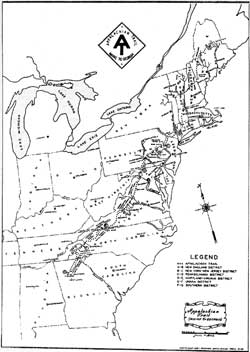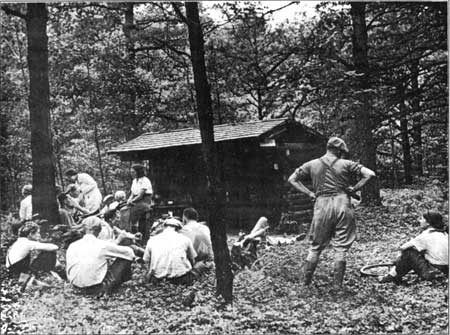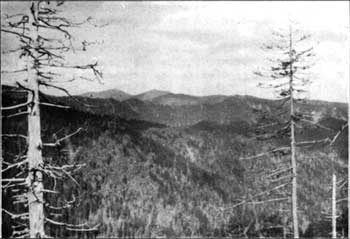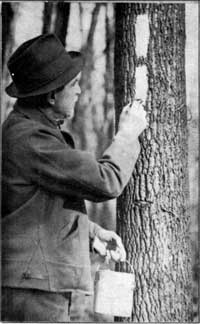|
THE APPALACHIAN TRAIL
And the Shenandoah and Great Smokies
BY MYRON H. AVERY
Chairman, The Appalachian Trail Conference

(click on image for an enlargement in a new window)
|
The Appalachian frail is too well-known a project to
require any extensive elaboration for those who deal, professionally,
with the recreational areas in the eastern Atlantic States under the
jurisdiction of the National Park Service. It is a route for foot
travel, distinguished, it may be said, by its practically endless
character. As it winds its course through fourteen states of the
Atlantic seaboard, it presents a unique opportunity for a study of the
changing zones of botany, geology and kindred sciences - a fascinating
pursuit for even those who observe such features only casually. For
instance, as one traverses the eastern Great Smokies along their
6,000-foot ridge crest, the traveler may well believe himself back again
in the cathedral-like spruce and fir forests of the Maine woods. The
Appalachian Trail Conference and its affiliated groups have also served
as a medium for conveying to the National Park Service their points of
view and suggestions.
But this project, of late, has acquired a deeper
significance. The national parks are in themselves a distinct type of
recreational area. Perhaps to those who forecast and determine the
future of these areas it would seem illogical and unnecessary that still
another type of recreational area should be created within the confines
of a national park. And it would seem all the more extraordinary that
this new type of area should exist for the benefit of a decided
minority. Yet such a development has occurred during the past two years.
The Appalachian Trail in the national parks - and we deal here with the
Shenandoah and Great Smoky Mountains National Parks - has assumed a
unique significance. This is not without importance even in a protected
area such as a national park.
From a mere trail it has become a narrow zone which
has received the status of a protected, insulated area. Here no new
paralleling motor roads are to be built. Where roads are now within a
mile of the Trail and where feasible, the Trail is to be relocated. A
system of simple shelters is to be built along the route. No development
generally imcompatible with the Trail is to be permitted in this zone.
The creation of this status has its genesis in an agreement executed
between the National Park Service and the U. S. Forest Service in
October, 1937. Subsequently thirteen of the fourteen States through
which the Trail route passes have adhered to the Trailway Agreement. The
area affected in the national parks is 159 miles, being divided almost
equally between the Shenandoah and the Great Smoky Mountains. The
significance of this agreement will be appreciated.
I have referred to the agreement as a boon to a
minority but I also view it as a distinct benefit to the National Park
Service. The pressure on the National Park Service to develop further
these two areas is a matter of common knowledge. It perhaps may be
beside the point to overstress their primitive aspect, for much of the
terrain in these two parks had been modified and altered in the course
of the economic development of the eastern United States. However, given
protection and with the benefit of trained and far-seeing planning,
these regions bid fair to revert to the primeval and become an
indication of the type of land that our forefathers knew. Pressure on
the Service for development will be ever-present. The ridge crest of
these areas is particularly susceptible. It will be readily understood
that the Trailway Agreement thus affords a medium for the preservation
of the existing status. While these agreements are not as unchanging as
the laws of the Medes and Persians in that they can be abrogated by six
months' notice, they do represent a distinct declaration of policy and
it may be presumed that neither the Service nor any state will reverse
its policy in this connection without overwhelmingly valid
considerations.
The effect of the Trailway Agreement on the future of
the ridge crest sections of these parks may be noted here. The Skyline
Drive in the Shenandoah National Park is an accomplished fact. In some
sections, by accident of terrain, the Trail and the Drive are in a
proximity which could be avoided now only by dropping the Trail an
undesirably long way down the mountain crest. Therefore, in the
Shenandoah National Park, where the situation was fixed when the
Trailway Agreement came into effect, no major change of route in the
Trail appears to be of advantage at the present moment.
The situation in the Great Smokies is quite
otherwise. This agreement is a shield which the Service may find of
advantage in resisting pressure for further road development along the
ridge crest of the Great Smokies. The agreement is, moreover, of
distinct value as a manifestation of the policy of the Service. It
should be recognized as such by those who declare themselves to be
vitally concerned with the preservation of the primeval and primitive.
The significance of this agreement and its effect, as long as it remains
unaltered, should be thoroughly appreciated. For its policy in this
connection the Service should receive due credit.
The existence of the Appalachian Trail has also been
of value in the development of these parks. It has brought to the
Service the view point of the users of these trails. A trail is
completed, physically, when, shall we say, the CCC detachment has
finished the grading. It is then, however, far from a usable thing. It
requires a definite system of signs; it must be mapped; essential
guidebook description must be prepared to induce its use. Further - and
this is of importance - a system of shelters, having due regard to the
practical situation, must be built. This is a matter of very real
concern in a region such as the Great Smokies where torrential rains are
experienced. The technician dealing with his specialty may not
appreciate all these essentials.

A TYPICAL LEAN-TO ON THE APPALACHIAN TRAIL
Thus, a well-planned shelter from an architectural
point of view often leaves much to be desired from the practical point
of view of the shelter user. In addition, the through Trail, which we
may regard as the master trail in each park, needs to be fitted in and
coordinated with the route to the north and south, outside of the park
boundaries. Private land ownership on each side of the park may produce
an anomalous situation of a trail ending, practically, nowhere.
Much progress has been made along these lines. We
note the situation in the Great Smokies. Since the problems have been
intensively pursued by the Conference after its meeting at Gatlinburg
some two years ago, eight lean-tos along the 62 miles of Appalachian
Trail here have come into existence. These are at intervals of an easy
day's journey for the traveler who would devote more time to the rewards
of his route. For the traveler who moves at a faster pace, the device of
"skipping" a lean-to meets his requirements. We are told that signs,
adequately designating the junction of all side trails and the main
Trail, have been installed for two-thirds of the Great Smokies. A more
reliable maintenance program for Western Smoky - where the Trail is
marked by paint blazes and an unworked footway - bids fair to care for
the problems reported here of inadequate Trail maintenance. A trail of
the type that exists in Western Smoky requires, of course, far more
frequent attention than the graded type where the route is
unmistakable.
While the Shenandoah is forced to yield the palm to
the Great Smokies as far as the lean-to situation is concerned, its
trail system, regarding the Appalachian Trail as the trunk line from
which side trails radiate to points of interest, has reached a stage
near completion. With the cooperation of the Potomac Appalachian Trail
Club, this park has carried out a systematic program of trail signing.
Maintenance problems are being systematically cared for. In addition to
five closed shelters available along its route, the open lean-tos for
the north half of the park, accessible to all comers, will have been
completed by the spring of 1940. The next year should see this chain
well toward completion.
I have emphasized that this recreational area of The
Appalachian Trailway is for a minority interest. Those who camp, walk
and seek their own recreation on foot represent a decided minority.
Perhaps at times their presence and views have been considered not an
unmixed blessing. Certainly, in terms of representation and use, the
cost of the construction of these trails (albeit a lower standard might
well serve the purpose) is disproportionate with the cost of highway
construction. This theory, of course, carried to its logical conclusion,
would overrun the national parks with roads. Trails, their users, and a
trail system may therefore, well be regarded as a means of defense
against over-development. As such trails and trail development are an
essential and an integral part of our park system, their existence is
justified on grounds of proper planning and use and not by a census of
the number of trail users and automobile riders, respectively. It is
perhaps well to appreciate this factor and evaluate it. At times,
emphasis on this comparison and insufficient use of trails (statistics
entirely correct in themselves), emanating from the officials in charge
of these areas, may unwittingly tend to create the impression that the
roads and kindred appurtenances are, in their view, the only
developments which justify the expenditure and activity involved. Such
an impression is indeed an unfortunate one to be abroad, for it can form
the basis of unfair and improper criticism of the Service policy. To
this end, the Trailway Agreement, as representing a distinct boon to
what we must admit without question is a decided minority, forms a very
useful answer of a recognition of the part that trails and trail systems
play in contrast with overdevelopment.

View from the Appalachian Trail in Great Smoky Mountains
National Park.
|
Perhaps when pursued to their ultimate conclusion,
these suggestions of inadequate use of any aspect of the recreational
features of the parks except the roads disclose some failure on the part
of the authorities in charge of these areas to appreciate the
practicabilities of the situation. It is not enough to have a trail
(ummapped, unsigned, unrecorded) built to some outstanding feature. It
is essential to have the existence of a route publicized and made known.
The mere completion of the trail will not, ipso facto, insure its use.
Yet one looks in vain for any activity which would publicize or
stimulate the use of these trails in the eastern parks. The Service has
available no maps, no guidebooks or publicity which meets this essential
need. An instance, however, of an approach to the problem is the
large-scale mounted maps being erected by the Landscape Architect along
the Skyline Drive in the Shenandoah National Park where there are trail
connections with the Drive. The outing clubs, as a voluntary
contribution, have picked up where the Service stopped. They have issued
the only maps and guidebooks for the area, and endeavored to stimulate
the use of these facilities through the medium of their publications.
Naturally, the response to this needed publicity manifests itself first
in the membership of those groups and this, curiously, brings the
suggestion that the facilities are being provided, with much expense,
for the benefit of a few organizations. The résumé of this
situation means this. A trail is not to be afflicted with some
apochryphal character. Its building is only the initial step. Granted
that facilities to that end have been inadequate, those who stress
insufficient use of any park facility except the roads must recognize a
failure to complete the job, to put it bluntly. The clubs and the
Conference have endeavored to remedy this deficiency to the extent their
limited resources permit and have to some degree.

A member of the Trail Club applying the type of blaze
used in the western Smokies to indicate a turn.
|
While this résumé is somewhat detailed,
it points to two factors in the situation of controlling importance. The
first is the assurance that the Service, through the Appalachian
Trailway Agreement, holds out to those who fear for the future of the
ridge crest in these areas. The second is that the Trail system - a
recreational feature of the park - through its medium of fitting into
the Appalachian Trailway Agreement, has been brought to a state of near
completion and better utilization than would have occurred had the
matter been pursued independently.
There is a third area under the jurisdiction of the
National Park Service which perhaps can be best summarized by saying
that it presents an outstanding problem to the Appalachian Trail
Conference. Perhaps the least said about the area the better. In any
event, it is a tribute to the original location of the Appalachian Trail
that the route of the Blue Ridge Parkway should be almost squarely
imposed upon it for its entire length of 150 miles. This section along
the curving rim of the Blue Ridge crest in Virginia is a section very
little frequented, inaccessible and somewhat removed from the activities
of maintaining organizations which care for the Trail elsewhere.
Perhaps in the course of economic development which
is manifesting itself here independently of the Blue Ridge Parkway, its
fate might have been sealed anyway. What relocations can now be made to
advantage are being made at the present time. For the most part, the
Trail parallels the Parkway. Ultimately, it is planned to make the last
major change in the Appalachian Trail route by shifting this section far
to the west through the publicly owned lands in western Virginia, which
afford a possibility not available at the time the Trail route was
originally projected.
This résumé of the development of the
Appalachian Trail in the areas under the jurisdiction of the National
Park Service is perhaps well made at this time to make clear the
situation to all those interested in these regions. Its primary
significance as a "Maginot Line" to those who fear overdevelopment and
as the perfection of a "finished" trail system seems at the moment - if
one's vision of the forest is not too much clouded by the presence of
the trees - to be outstanding. Perhaps it will also not be without
future significance.
|

